|
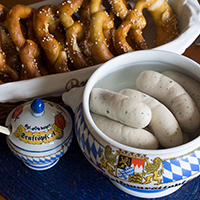 |
Munich Weisswurst served in a traditional
Bavarian porcelain bowl,
salty pretzels and sweet mustard. |
The Sausage Saga, part 4: The Munich weisswurst - the beauty queen of the wurst world.
A number of good things come from Munich: beer, Bayern Munich football, BMW ... and the Weisswurst!
If bratwurst is the kings of the sausage world when it comes to grilling,
the Weisswurst is the king of sausages when it comes to aesthetics.
Served in pretty porcelain bowls, weisswurst belongs into the greater sausage family of "Brühwurst",
sausages that consist of very finely ground meats that have been smoked, baked, cooked, fried
or otherwise heat treated prior to being stuffed into the casing. Other examples
of the Brühwurst are Vienna and Frankfurt sausages (Wiener Würstchen, Frankfurter Würstchen),
Bockwurst from Berlin, Debreziner from Hungary, the Burenwurst, Krainer and Käsekrainer from Austria,
Jagdwurst, Schinkenwurst, Bierwurst, Leberkäse (meatloaf) Krakauer from Kraków,
Lyoner (Cervelas) from Lyon, Mortadella from Bologna.
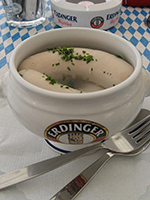
Weisswurst served in a bowl. |
The weisswurst is one of the most famous Munich specialties, eaten as a snack
with sweet Bavarian mustard, pretzels and wheat beer. It can be found
at street festivals, at the Oktoberfest and in every cafe and pub in Munich.
It is even served in the corner of the main exhibit hall at the BMW Museum at the 1 Olympiapark.
Like the car, it is quintessentially Bavarian and its presence in the same room alongside some
of the most sophisticated race engines (i.e. that of the M5), paints a unique picture of what
Bavaria really is: a blend of laid back rustic placidity combined with 21st-century hi-techness.
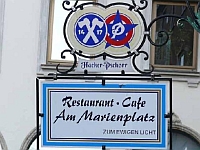
The restaurant where weisswurst was invented. |
Weisswurst is said to have been invented in 1857 at the pub "Zum Ewigen Licht"
(The Eterlan Light, now Café "Am Marienplatz") on Marienplatz in Munich.
Story has it that a butcher named Sepp Moser working at the Eternal Light
invented it by mistake while making thin veal bratwurst. Preparing a festive Fasching dinner
(Mardi Gras before Ash Wednesday), Moser ran out of sheep casing
and as bad luck would have it, guests were already waiting. He sent out his apprentice
who came back with pork intestines instead of sheep. These were to wide and too tough for
the bratwurst he was making, but in an emergency he filled them anyway. He decided not
to fry them but boil them instead fo fear they might burst while frying.
Notwithstanding the problems during production, the guests loved
the new wurst so much that it was instantly elevated to a noble status
in the world of wurst!

Weisswurst with mustard and a pretzel. |
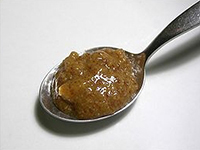
Sweet Bavarian mustard. |
The original Weisswurst was made of veal, some lard, all finely ground,
and seasoned with parsley, lemon, mace, onions,
ginger and cardamom, stuffed into a pork-intestine casing. It is separated into individual sausages
10-12 cm (4-5 inches) and about 2 centimeters (1 inch) in thickness. It is prepared by boiling
and served in pairs on a plate or in a traditional white porcelain bowl with a lid,
and eaten with a pretzel and sweet Bavarian mustard.
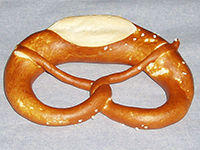
Salty pretzel. |
There are other theories about the origin of Weisswurst. One holds that it originated
in France as "boudin blanc", a white pork sausage made of finely ground meat, liver and heart.
The casing is never eaten (only wurst greenhorns would do that...).
The proper technique of eating Weisswurst requires a fork and a knife,
slicing a long incision in the middle of each wurst, down its longitudinal axis,
then stabbing each half with a form and peeling the casing off with the knife.
A step-by-step instruction in proper Weisswurst consumption is given
here.
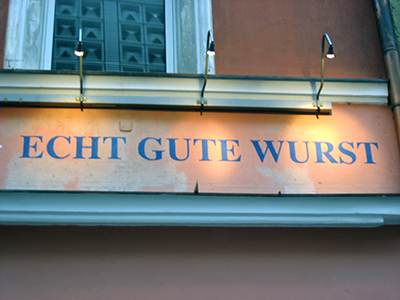
Sources:
- Würstchen.de
- Wurst.de
- Wikipedia
back to Radim and Lisa's Well-Travelled Cookbook | email us
Last updated: May 10, 2014
Certain images from Wikimedia Commons, used under the terms of the GNU Free Documentation License.
|






